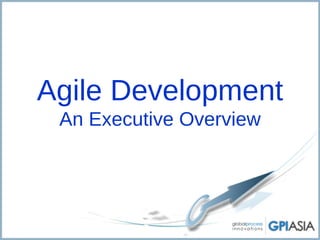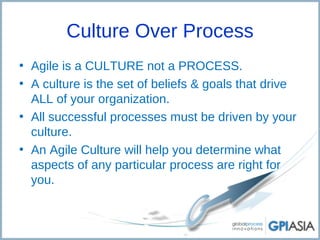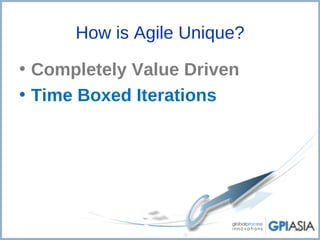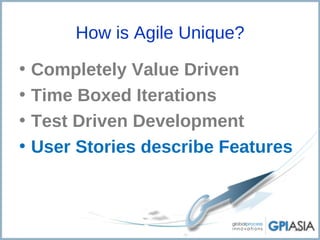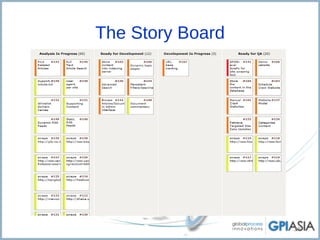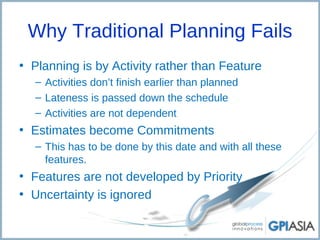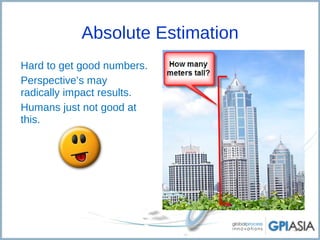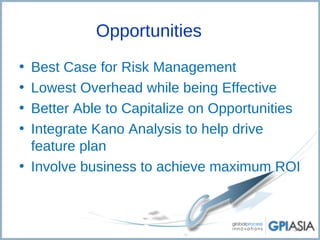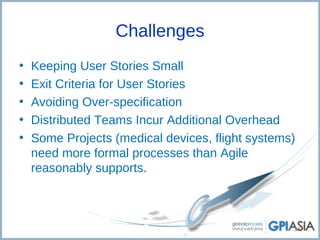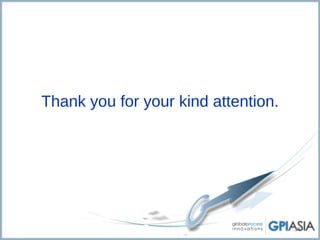Introductionto Agile Executive Overview Gpi Asia Rev2
- 1. Agile Development An Executive Overview
- 2. Professional Background Benjamin Scherrey – Proteus Technologies, Ltd. • Accidentally started first company, Business Data Management, in 1989. • Found out managing software development was very hard!! • Read Tom Gilb’s “Principles of Software Engineering Management” • Discovered iterative development, metrics & clear requirement definitions! • Got involved with ISO-9001 – learned that processes can go wrong! • Early adopter of SEI’s Capability & Maturity Model • Started second company, Proteus Technologies, in 1994. • Finally became Agile in 2002 and enjoy software development once again! Twitter @proteusguy scherrey@proteus-tech.com
- 3. Professional Background Sinaporn Suebvisai – Proteus Technologies, Ltd. • Bachelor Degree in Computer Engineering from Chulalongkorn University in 2001 • Worked as Research Assistant at NECTEC for 1 year • Master Degree from Computer Science School, Carnegie Mellon University, in 2004 • Joined Thomson Reuters in 2004 as Software Engineer • Became Development Group Leader in 2007 • Led the effort to adopt Agile process into the team, and kept making improvements • Joined Proteus Technologies Co. Ltd. as Thailand's first ever Agile Evangelist in 2008 sinapam@proteus-tech.com
- 4. Another Process? • Software Development : Art or Science? The Art of Managing Complexity • Unfulfilled Promises • False Belief that we know more about a project than we possibly can. • Hiding from Risk is NOT Managing Risk! • …quit pretending and get to the real value.
- 5. What is Agile? The Agile Manifesto – Utah 2001 Individuals and interactions over processes and tools Working software over comprehensive documentation Customer collaboration over contract negotiation Responding to change over following a plan 5
- 6. Agile Utilizes Best Practices • Evolutionary Delivery vs. All at Once – Barry Boehm’s Spiral Model • User Stories – Kent Beck’s Xtreme Programming • Short, Focused, Meetings of Cross Functional Teams – Jeff Sutherland, et al, SCRUM
- 7. Culture Over Process • Agile is a CULTURE not a PROCESS. • A culture is the set of beliefs & goals that drive ALL of your organization. • All successful processes must be driven by your culture. • An Agile Culture will help you determine what aspects of any particular process are right for you.
- 8. How is Agile Unique? • Completely Value Driven 8
- 9. Mayo-Smith Pyramid Grandiose Designs Incur Grandiose Risks Scope fixed, budget & schedule may suffer. Focus on immediate, practical functionality maximizes value of each increment while reducing risk. Scope flexible, budget & schedule under control. 9
- 10. Agile Fixes Costs & Schedule to Drive Features © www.StickyMinds.com 10
- 11. How is Agile Unique? • Completely Value Driven • Time Boxed Iterations 11
- 12. Time Boxed Iterations • Iterations are fixed length. – Typically 2 weeks, no more than a month. • Every iteration ends with a demo and retrospective. • Short Iterations allows for frequent directional corrections. • Reduced Cycle time is Major competitive advantage!
- 13. What we do in Iteration Close-down • Conclude the Iteration – Which stories have been closed • Update the Progress in relation to the Release • Demo – Customers are happy when they see progress – Early feedback from customers 13
- 14. How is Agile Unique? • Completely Value Driven • Time Boxed Iterations • Test Driven Development 14
- 15. Test Driven Development • Unit Testing – Integrated in the build environment. • Continuous Integration – Always ready to ship. Allows you to embrace change! • Automated Testing – Ensure constant quality and prevent regressions. • Fully integrates the test group and developers love writing tests! 15
- 16. How is Agile Unique? • Completely Value Driven • Time Boxed Iterations • Test Driven Development • User Stories describe Features 16
- 17. What is a User Story? • User Story is a Brief statement of Functionality but told from the User’s perspective. As a <stakeholder>, I want to <goal> so that <reason>. • INVEST in User Stories – Independent – Negotiable – Valuable – Estimable – Small – Testable
- 18. User Story Description Story Card Story ID Notes from Discussion Exit Criteria Story Points
- 19. The Story Board 19
- 20. The Story Board 20
- 21. How is Agile Unique? • Completely Value Driven • Time Boxed Iterations • Test Driven Development • User Stories describe Features • Planning & Estimating with Story Points 21
- 22. Why Traditional Planning Fails • Planning is by Activity rather than Feature – Activities don’t finish earlier than planned – Lateness is passed down the schedule – Activities are not dependent • Estimates become Commitments – This has to be done by this date and with all these features. • Features are not developed by Priority • Uncertainty is ignored
- 23. Estimating the Agile Way Estimating the Real World Each building is a task whose complexity is determined by its height. 23
- 24. Absolute Estimation Hard to get good numbers. Perspective’s may radically impact results. Humans just not good at this. 24
- 25. Absolute Estimation Humans good at making relative judgments. Consensus can be reached quickly. Assessment accuracy is “close enough”. 25
- 26. Story Points Support Relative Estimates • Measure Relative Complexity of User Stories • Considers the Entire Efforts of Dev & Test • Use the Fibonacci Sequence in order to prevent arguments over a 10% estimate difference. – 1, 2, 3, 5, 8, 13, 21, etc… • Far less likely for management to successfully play “Time Math” with. 26
- 27. Velocity & Release Planning • Velocity is the average number of story points achieved over the last several iterations. • A Release is a set of User Stories (Features) that must be present in order to be worth shipping. • Velocity allows you to estimate your release date while still being responsive to changing requirements by trading out User Stories. 27
- 28. Why Agile Planning Works • Instead of creating the perfect plan, create a plan that is useful right now – But update plan often • Effort Size and Duration are separated – Duration estimate is harder to match • Plans are made at different levels • State Uncertainty in no Uncertain terms • Tracking is at the Team level, not Individual • Plans are by Features, not Tasks – Team understands more of the product • Transparency Builds Trust and Credibility!
- 29. How to Better Utilize Agile • Use an Agile Coach as a full team member, not process enforcer. • Team-member Driven Process • Have Small Cross-Functional Teams that work side by side. • Automate Everything 29
- 30. So what do we get from being Agile? • Happy customers – they get what they really want! • Faster feedback • Quick response to changes • Trust from customers due to Transparency • Increase in Team Participation • Risk management built-in • Better software quality 30
- 31. Opportunities • Best Case for Risk Management • Lowest Overhead while being Effective • Better Able to Capitalize on Opportunities • Integrate Kano Analysis to help drive feature plan • Involve business to achieve maximum ROI 31
- 32. Challenges • Keeping User Stories Small • Exit Criteria for User Stories • Avoiding Over-specification • Distributed Teams Incur Additional Overhead • Some Projects (medical devices, flight systems) need more formal processes than Agile reasonably supports. 32
- 33. Thank you for your kind attention. 33
- 34. References Agile Estimating and Planning - Mike Cohn Principles of Software Engineering Management - Tom Gilb Agile Retrospectives: Making Good Teams Great - Esther Derby, Diana Larsen, Ken Schwaber Email me: scherrey@proteus-tech.com Web site: http://proteus-tech.com Follow me on Twitter: @proteusguy 34

